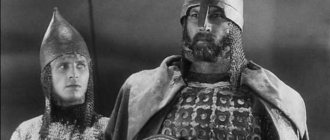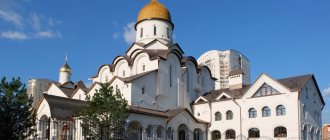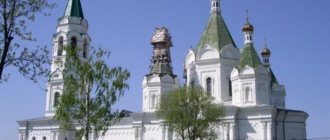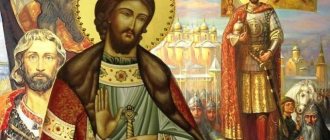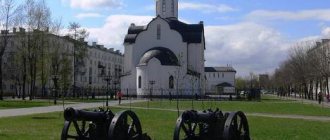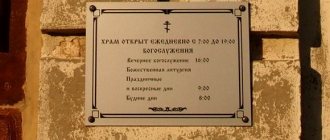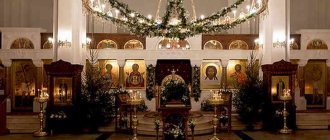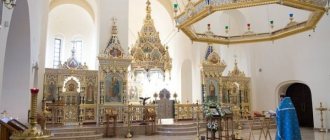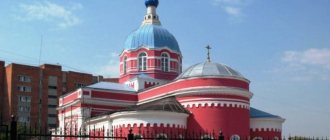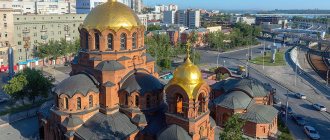At all times, Rus' gave birth to heroes who became its intercessors in dark times. Many of them are known not only in our country, but also abroad. One of these people is Alexander Nevsky, who has been referred to as “saint” and “great” for many centuries. His relics are credited with miraculous powers, and information about them has been preserved in various chronicles since the fourteenth century. Some sources indicate that already on the second day after the prince’s burial, people found a cure for various ailments at his grave. Therefore, popular rumor even before the official canonization of the prince declared him a saint.
The relics of Alexander Nevsky are one of the most precious Russian shrines. Our article is dedicated to this great man and his activities to save Rus' from the invaders. We will also answer the main questions of the article, where the relics of Alexander Nevsky were located in different periods of time, and why they are so dear to the hearts of Orthodox Christians.
Historical portrait of Alexander Nevsky
Unfortunately, now not every schoolchild can tell what exactly the Grand Duke did for Rus'. Therefore, before starting the story about the relics of Alexander Nevsky, it is necessary to at least briefly list his services to the Slavs.
According to chronicle sources, the future protector of Rus' was born in the twentieth year of the thirteenth century. His earlier childhood was spent in Pereslavl-Zalessky; Alexander grew up in Novgorod, where his father was sent to reign, whom the young man accompanied on all military campaigns. It was a difficult time for Rus' - on the one hand, the Mongol horde was burning villages and capturing cities, and on the other, the Swedish army was approaching the borders of the state. Young Alexander had to defend his homeland from foreign invaders.
In the summer of one thousand two hundred and forty, he won a brilliant victory over the Swedes on the Neva River, for which he received his nickname, under which he went down in history. For two years, fierce battles took place near the western borders of the state, and on April 5, 1242, Alexander Nevsky managed to defeat the knights of the Teutonic Order on Lake Peipsi. This victory finally deprived the Swedes of the hope of capturing Russian lands, and the name of the young Prince Alexander became known far beyond the borders of Rus'.
Now he was faced with a different task - to protect the country from the east and negotiate cooperation with the Mongols. It was with this mission that the military leader went with his father to the Horde.
Historians note that Alexander Nevsky was extremely perspicacious. He managed to negotiate peace with Khan Batu, and even acted on his side against Mongolia. There were legends about the relationship between the khan and the Russian prince; chronicles mention that they were often called brothers. Alexander Nevsky even managed to persuade Batu to accept Christianity, which further strengthened their relationship and all agreements between the two rulers. The prince's plans were to unite the Russian and Tatar lands under powerful rule in order to counter any threats from the west and east. But these dreams were not destined to come true.
On November 14, 1263, returning from Sarai, the prince fell ill and quickly died. The nearest city where the body could be brought was Vladimir. This is where the mourning delegation went. However, even after his death, the great protector of Rus' managed to surprise his subjects and church leaders.
What is actually the main feat of the Grand Duke?
For almost 7 decades, while the holy relics of the prince remained in oblivion and neglect, Soviet propaganda intensively mythologized the image of Alexander as a great warrior, commander, and defender of Rus'. The film by S. Eisenstein (1938) is well known, where the commander is played by the famous Nikolai Cherkasov.
Less is known about the fact that on the Order of Alexander Nevsky (existed from 1942 to 1991) it is the profile of the actor, because not a single lifetime image of the blessed prince has been preserved.
The great battles of Alexander - the Neva and the Battle of Lake Peipus - also remained in people's memory thanks to the power of cinematic art. Only modern historians have found out: the significance of these battles was much less than Alexander’s refusal to the Pope, who offered him help in exchange for betraying Orthodoxy. And the prince most likely received the nickname “Nevsky,” according to a modern researcher of the era, I.N. Danilevsky, simply because he had some family lands near the Neva River.
The beginning of a new understanding of the life path of the noble prince almost coincided with the return of his honest relics to the revived monastery. It happened on June 3, 1989.
Miracles performed by Saint Alexander after death
In order to get to Vladimir and bury the ashes of the deceased prince, his squad took nine days, and here miracles began to happen, which became the basis for the further canonization of Alexander Nevsky. Surprisingly, after nine days the body did not begin to decompose. The burial took place on November 23 in the Nativity Monastery in the city of Vladimir. During the trial, Metropolitan Kirill intended to unclench the prince’s fingers in order to insert a letter into them. But to the horror of all those present, Alexander himself extended his hands for spiritual guidance and immediately accepted the paper. The clergy declared it a miracle and considered it divine glorification.
Literally a few weeks later, ordinary people began to come to worship the prince’s ashes, many of them prayed for healing and received an answer in the form of newfound health. The rumor about miracles happening in the Nativity Monastery quickly spread throughout Rus'.
History of the veneration of relics
The veneration of Alexander Nevsky arose at the burial site of his body in the Nativity monastery in the city of Vladimir immediately after his death. During the farewell ceremony, a miracle occurred: Metropolitan Kirill, who was leading the ritual, approached the coffin to present the prince with a spiritual letter, but the right hand of the deceased itself stretched out and accepted this sacred leaf.
Holy relics of the blessed prince Alexander Nevsky
After the clergyman spoke about this event, many people began to consider Alexander a saint and praised him in prayer chants.
- The book entitled “The Life of A. Nevsky” was known in Moscow, Veliky Novgorod and Pskov. Since the 16th century, people have addressed the holy defender of the Russian land on the eve of battles.
- The sexton of the Church of the Nativity of the Virgin Mary said that in 1380 (on the eve of the battle on the Kulikovo Field) a spirit appeared to him, giving a blessing to “his great-grandson,” Prince D. Donskoy.
- After this momentous battle, an official autopsy and further identification of the remains of St. Alexander took place. Having stayed in the ground for 117 years, the relics remained incorruptible and fragrant. Metropolitan Cyprian solemnly announced that Alexander would henceforth be called blessed, a church celebration was held for the great intercessor of the fatherland, canons and icons were painted in his honor.
- The veneration of relics expanded from the 15th to the 16th centuries. The Russian Orthodox Church canonized A. Nevsky as a miracle worker. Based on the book of life (XIII century), a canonical biography was created.
- One of the miracles occurred in the presence of John IV, who was making a campaign against Kazan and stopped along the way in Vladimir. The king's close associate healed his hands by performing a prayer service at the relics of St. Alexander. Subsequently, churches and monasteries were built on the territory of Rus' in honor of the great miracle worker and defender of the fatherland.
Discovery of the relics of Saint Alexander
For more than a hundred years, people came to the grave of the protector of the Russian land, and one day one of the monks had a vision of the need to open the princely burial. With great honors, the grave was opened and they froze in amazement - an incorruptible body appeared before those gathered - the relics of Alexander Nevsky. This was another evidence of the miracles of the holy prince. They were taken out of the ground and placed on a reliquary (ark or coffin), where the holy relics were located until the eighteenth century. Alexander Nevsky was canonized by the church only in 1547, which, however, did not stop people from treating the ascetic prince as a saint who gave his whole life to defend his state.
The Mystery of the Holy Relics
Many historians are seriously interested in the question of where the relics of Alexander Nevsky are kept today. After all, the issue of the loss of this relic back in the fifteenth century is still being discussed in scientific circles.
The fact is that many skeptics mention the information contained in the annals of the sixteenth century. They indicate that during the May fire at the end of the fifteenth century, almost the entire Nativity Monastery burned down, and with it the relics of Alexander Nevsky turned to ashes. But already in the chronicles of the seventeenth century this event is described a little differently. The author clarifies that, allegedly, the monks saw with their own eyes how the hall where the relics of Alexander Nevsky are located was miraculously spared by fire. And they remained the only ones unharmed in the Nativity Monastery.
Of course, now it is difficult to say where the truth is in this story. One can only hope that the relics remained visible even after the fire, which means that no one could replace them. It was impossible to leave such a hoax unnoticed, so church ministers are absolutely sure that the real relics of Alexander Nevsky are still kept within the temple and leave it only on rare occasions, when they are transported to different cities, cathedrals, churches in our country and neighboring countries in order to strengthen flock in faith.
However, the topic periodically flashes in the media that an inventory dated 1922 indicates that the silver shrine contained only twelve fragments of bones without a skull. No one knows whether this was the same relic, because today no one can solve the mystery of the relics. History tends to leave many questions unanswered.
Return of the relics of the heavenly patron of the Nevsky region
30 years ago, the relics of the heavenly patron of St. Petersburg, Alexander Nevsky, were transferred to the Trinity Cathedral
On the morning of June 3, 1989, the clergy, led by Bishop Proclus of Tikhvin and Bishop Leo of Tashkent, came out of the Trinity Cathedral of the Alexander Nevsky Lavra and headed to the Holy Gates in a procession of the cross. The parishioners covered their entire path to Alexander Nevsky Square with fresh flowers and spruce branches.
In 1547, the Russian Orthodox Church canonized Alexander Nevsky, canonizing him as a saint.
Metropolitan Alexy of Leningrad and Novgorod met them on the square. The clergy took out the ark from the car parked next to him. Under the ringing of the bells of the Lavra and the bells of all the city churches, the ark was brought into the cathedral, and after the Divine Liturgy was carried out around the temple. Then the ark was installed in its original place under the canopy behind the right choir. The relics of the heavenly patron of St. Petersburg, the Holy Blessed Prince Alexander Nevsky, after 67 years, returned to the Alexander Nevsky Lavra.
From Vladimir to St. Petersburg
Grand Duke Alexander Nevsky died on November 14, 1263 at the age of 42 in the Gorodets monastery, near Vladimir, where he was returning after a trip to the Horde. Then his body was transported to Vladimir and interred in the Nativity Monastery.
In 1547, the Russian Orthodox Church canonized Alexander Nevsky, canonizing him as a saint. Such a late canonization is largely due to an ambivalent attitude towards the activities of the prince. On the one hand, he became famous for his victories over the Swedish and German knights, stopping their expansion to the east. On the other hand, his close relationship with the Horde was regarded by many as almost a betrayal of national interests. Only with the passage of time did it become obvious that Alexander Nevsky’s diplomacy was primarily aimed at preventing new Horde invasions and gaining time to restore the military-economic potential of Rus'.
The shrine, in which the relics of Alexander Nevsky were located, is located in the Hermitage as a Baroque monument. Its construction took 1.5 tons (!) of high-grade silver
Even before his canonization, in 1380, local veneration of the prince as a saint began: his remains were dug up and placed in a shrine.
According to the lists of the Nikon and Resurrection Chronicles of the 16th century, during a fire in Vladimir that happened in 1491, the relics burned along with the Monastery of the Nativity of the Virgin. However, in the records of the same chronicles, dating back to the 17th century, it was stated that the remains of the prince were miraculously not damaged by the fire. It is now impossible to establish how it actually happened, but the Russian Orthodox Church adheres to the version that during the fire the relics were severely damaged, but, nevertheless, were partially preserved.
Be that as it may, after the fire, the shrine with relics continued to be an object of worship for believers, and after the canonization of Alexander Nevsky, they became an “all-Russian” shrine, to which numerous miracles of healing were attributed. So, in 1551, Tsar Ivan the Terrible, before his campaign against Kazan, spent a whole week in the Nativity Monastery and later claimed that he had cured his sore hand from the relics.
The relics remained in Vladimir until mid-1723, when Peter I ordered their transfer to the new capital - St. Petersburg. First, the reliquary with the relics was transported to Shlisselburg, and on August 30, 1724, they were loaded onto a galley, helmed by the Tsar himself, and transported to the Alexander Nevsky Monastery. When the crayfish was carried ashore to the sound of bells and artillery salutes, Peter opened it with the key, looked inside, closed it and threw the key into the Neva. After this, the reliquary was installed in the monastery.
Empress Elizaveta Petrovna came to power , she ordered a new shrine to be made for the relics, which took five years to create. Made according to the drawings of the artist Georg Groth and the sketches of the engraver Jacob Stehlin , the shrine became a real work of art. Its construction took 1.5 tons (!) of high-grade silver, as well as valuable wood.
It consists of seven parts: a small ark made by Moscow craftsmen in 1695, a sarcophagus with a lid, a large five-tier pyramid, two pedestals with trophies and two candlesticks. The sarcophagus and pyramids are decorated with numerous bas-reliefs and sculptural compositions.
In the middle of the second tier of the pyramid there is a bas-relief of Alexander Nevsky with a banner in his hand, on the sides of the sarcophagus there are reliefs depicting the most important events from his life: the Battle of the Neva, the Battle of the Ice, the liberation of Pskov, as well as the scene of the death and burial of the prince.
The southern side of the sarcophagus is decorated with a medallion with an epitaph composed by Mikhail Lomonosov . Another of his epitaphs is minted on two silver shields, which are held in the hands of two silver angels sitting on the upper corners of the pyramid.
“All the details are skillfully cast and as a whole make up the luxurious decoration of this unique work, which amazes with the grandeur of the design and the breadth of creative imagination,” writes in his study “Monuments of the 18th century. and the first half of the 19th century." art historian Galina Netunakhina .
In 1753, the relics of Alexander Nevsky were placed in a new shrine installed in the Annunciation Church, and in 1790, when the Cathedral of the Holy Trinity was built, it was transferred to this temple, where it remained until mid-1922.
Godless years
On February 22, 1922, the All-Russian Central Executive Committee (VTsIK) of the RSFSR issued a decree on the confiscation of church valuables “for the needs of the starving” of the Volga region and other regions of the devastated country.
On June 3, 1989, Bishop Alexy and the Minister of Culture of the RSFSR Yuri Melentyev arrived at the Kazan Cathedral, where, in the presence of representatives of the clergy and city authorities, they signed an act on the transfer of holy relics, after which they were transported to the Alexander Nevsky Lavra, where the ark took its historical place in Trinity cathedral
No ceremony was taken with the requisitioned valuables, many of which were unique works of art: they were often simply melted down and sold abroad “by weight.” Of course, the shrine with the relics of Alexander Nevsky, which contained as much as one and a half tons of silver, immediately attracted the attention of the Petrograd Council of Workers' and Soldiers' Deputies, headed by its chairman Grigory Zinoviev.
However, Metropolitan Veniamin of Petrograd and Gdov was not afraid to come out with a decisive protest against the planned desecration of the relics and the “confiscation” of the reliquary. He proposed a compromise: church values that are of great importance to believers will remain in their use, and in return, parishioners and clergy will collect and hand over to the authorities gold and silver corresponding to their weight.
But for the Bolsheviks, the seizure of church valuables was the basis for launching an anti-church campaign. In May 1922, with their support, the Higher Church Administration (HCU) of the Russian Orthodox Church was created, consisting of the so-called renovationists - representatives of the movement that arose after February 1917 and declared a course towards the “democratization” of the Orthodox Church and full support for the policies of the Soviet authorities. The VCU immediately announced the illegality of the patriarchate of Tikhon , who was detained by security officers and imprisoned in the Donskoy Monastery in Moscow. Bishop Antonin (Granovsky) became the head of the VCU . Thus, the fate of all “regional” metropolitans now depended on the pro-Soviet schismatics.
On May 12, 1922, an impressive delegation of representatives of the district party committees, military units and the press arrived at the Trinity Cathedral. In their presence the cancer was opened. The entire process was recorded by the famous photographer Karl Bulla .
According to the bulletin of the All-Russian Central Orthodox Church of the Russian Orthodox Church, published in 1923, “12 small bones of different colors (meaning from different relics) were found in the shrine of Alexander Nevsky, in Petrograd. In addition, the cancer turned out to have two identical bones of one right leg.”
The relics, placed in a small shrine, continued to be in the Lavra for some time, and then were transported to the Kazan Cathedral, where the State Museum of Religion and Atheism was established in 1932. And the large silver shrine went to the State Hermitage, where it remains to this day.
As for Metropolitan Benjamin, who was forced to watch with pain in his heart the desecration of the relics, after May 28 he delivered a message to the flock that Patriarch Tikhon had not renounced his post and should continue to be revered by all believers , he was arrested on charges of obstructing the seizure of church property. After a speedy trial, he was sentenced to death. The place of the Metropolitan’s execution, as well as his resting place, is still unknown...
Return
With the beginning of perestroika, the relationship between the Soviet authorities and the church began to change. In 1988, the Local Council of the Russian Orthodox Church was held in Sergiev Posad, the fourth after 1917. At it, a new Charter of the Russian Orthodox Church was adopted, and nine ascetics of Orthodoxy were canonized, including Prince Dmitry Donskoy , icon painter Andrei Rublev and Blessed Xenia of St. Petersburg .
“We prayerfully hope that the changed conditions of religious life in our Fatherland will allow us all to once again feel our spiritual kinship...”, said the appeal adopted at the Local Council.
...The next year, through the efforts of the future Patriarch of Moscow and All Russia Alexy II , who then headed the Leningrad and Novgorod Metropolises, an agreement was reached with the Ministry of Culture and the leadership of the State Museum of Religion and Atheism on the return to the Church of the relics of the Holy Blessed Prince Alexander Nevsky. At the same time, when experts examined the contents of the ark, no doubts were expressed that the remains belonged to the same person.
On the morning of June 3, 1989, Bishop Alexy and the Minister of Culture of the RSFSR Yuri Melentyev arrived at the Kazan Cathedral, where, in the presence of representatives of the clergy and city authorities, they signed an act on the transfer of holy relics, after which they were transported to the Alexander Nevsky Lavra, where the ark took its historical place in Trinity Cathedral, being placed in a temporary shrine.
As for the large shrine, it still stands in the Hermitage concert hall, despite repeated requests from the metropolis, supported in 2012 by Russian Minister of Culture Vladimir Medinsky . Director of the State Hermitage Mikhail Piotrovsky continues to insist on the need to find the shrine, an outstanding monument of Russian Baroque, proposing to make a copy of it for the Alexander Nevsky Lavra. Restoration of the shrine is currently ongoing. Perhaps in 2021, when Russia celebrates the 800th anniversary of the birth of Alexander Nevsky, this issue will finally be resolved.
Igor CHEREVKO
Share link:
St. Petersburg and Saint Alexander Nevsky
If you ask any resident of the northern capital where the relics of Alexander Nevsky are located in St. Petersburg, then we are sure that many will answer you correctly. But what connects the ascetic prince and this city of Peter? It’s simple - the saint is considered its patron, and this, naturally, was facilitated by the autocrat, who gave birth to the new Russian city at the height of the Northern War. It was thanks to the sovereign that the Alexander Nevsky Temple was built here, whose relics took the most honorable place in it.
Scientists were amazed by the strange design of the body of Alexander Nevsky
After opening the crayfish and unwinding the endless covers of purple satin, the scientists discovered a small pillow and a wooden box. There were several bones in it, namely:
- two incomplete tibias,
- one rib,
- remains of the temporal bones,
- fragments of collarbones.
A total of 12 small bones of different colors were found, most likely belonging to different organisms. The priests responded to this with a common quotation from the Bible, hiding the real forgery that took place in 1917.
The significance of the Holy Trinity Alexander Nevsky Lavra in St. Petersburg
Peter I was a very wise ruler, and all his actions were called far-sighted by his contemporaries and descendants, so he became interested in the holy relics for a reason. But let's talk about everything in order.
In 1710, the autocrat thought about building a temple in honor of the great protector of the Russian land from foreign adversaries. Let us remember that at this time Peter I had been at war with the Swedes for several years, and the people needed a symbol that would inspire and inspire all people without exception. The figure of Alexander Nevsky was perfectly suited to this role, because he also defended Rus' from the Germans and Swedes. The sovereign chose the town of Victory for the temple. Presumably it was there that the holy prince defeated the combined army of the Swedish king. But later it turned out that another victory of Alexander Nevsky was associated with these lands - over Jarl Birger in 1240.
In any case, the prince became not only a symbol of the invincibility of the Russian spirit, but also the protector of St. Petersburg, which became an outpost of Russian lands in the west. Based on this, in the spring of 1723, the sovereign ordered that the relics of Alexander Nevsky be transferred to the newly built monastery. In St. Petersburg they prepared for this event with special trepidation and care. After all, Peter I himself led the complex process, and, as you know, he did not forgive mistakes and miscalculations of his subjects.
Transfer of the relics of Alexander Nevsky: preparation for the event
In order to transfer the holy relics with all honors from Vladimir to St. Petersburg, a shrine was needed into which the shrine would be immersed. For this purpose, a certain Zarudny was chosen, who began manufacturing it in Moscow. The cancer was a real work of art:
- eight legs in the shape of a lion's paws;
- the legs were crowned with images of cherubs;
- the lid of the ark was decorated with the prince's coat of arms;
- the image of lion heads was applied to the reliquary - a well-known symbol of the resurrection from the dead;
- the structure was placed on a powerful stand;
- This product was crowned with a canopy with golden armor at the base.
In order for the transfer process to go smoothly, a special ritual was developed in the summer of 1723, which looked like this:
- a route was drawn up, deviation from it was strictly prohibited;
- Peter I's confidant should have been with the ark along the entire route;
- on land, the raku had to be carried by people replacing each other in different cities;
- in large populated areas, the mission of transporting the ark was entrusted to the clergy.
It was planned to transport the relics from Novgorod by water to St. Petersburg, where they would be met by the sovereign himself.
Alexander Nevsky (prince), relics: transfer to St. Petersburg
The date for the transfer of the relics was chosen by Peter himself and not at all by chance; in 1724 the long-awaited Peace of Nystadt was concluded, and this festive event was marked by the solemn consecration of the Holy Trinity Alexander Nevsky Lavra.
In July, the relics left the Nativity Monastery and began their journey to a new monastery in the northern capital. Peter I himself went to meet them and personally carried them off the yacht. Regiments in ceremonial uniform stood at the mouth of the Izhora River, and festivities on the occasion of the transfer of the relics of the holy prince continued in St. Petersburg for three days. At the same time, the sovereign ordered the thirtieth of August to be celebrated annually as a religious Orthodox holiday and intended to establish an order in honor of Alexander Nevsky. However, he did not have time, but his wife fulfilled the dream of Peter I by issuing a decree establishing a new state award.
Cancer in restoration
We walk around the workshop. Here are a variety of museum exhibits containing precious metals: a mirror and a lamp that belonged to various empresses, a box, a shield, an ancient goddess of such a beautiful age that it is decent to call it - about two thousand years.
Igor Karlovich manages to tell, show and sometimes turn on different devices - there are a huge number of them. Some were purchased specifically for work on the tomb of Alexander Nevsky. The restoration began when, during regular preventive inspections of the exhibits, it became clear that it could no longer be done without it. “The decision was made collectively. There were many meetings of restoration commissions, we discussed restoration technology, copying technology.”
Stop! Copying?
Igor Karlovich patiently explains: “During restoration, such a huge exhibit is dismantled into its component parts. Only during the restoration process is it possible to remove the forms from all components for subsequent possible copying of the exhibit, if such a decision is made and funds are found to carry out such work. The tomb was originally made by minters. Now there is an opportunity to use new technologies and produce it in a different way. Research has been conducted to determine which method of making it is better. We imagine how many master minters are now in our country. As you know, in the time of Elizabeth, minters were brought to the capital from everywhere, but even then the majority were foreign craftsmen, mainly Germans. In a word, manufacturing by hand now, when many processes are automated, is practically impossible; there is not the required number of highly professional embossers.
But now there is an opportunity, using the latest technologies, to grow all the elements of this unique exhibit. The smallest ones too. For example, nails and screws. The laboratory has special equipment on which you can create a 3D model, then a mold, then an exact copy of a particular part, preserving all the details of the original, even down to chips and scratches. During the restoration, many parts that were damaged, bent, or broken have already been restored. These are fastener elements that were most damaged during numerous assemblies and disassemblies of the exhibit (in the 20s, during the evacuation). If done manually, it can take up to three days of working time to make one screw or nail, but with the help of new technology it can be restored tens, sometimes hundreds of elements in one day. Impressive!
This is what the new technology consists of: first, for each element, a 3D mold is made from platinum silicone, reproducing micro-details invisible to the eye. The forms will remain “in shape” for several hundred years. So in the event of further restorations or losses, they can be repeated: in the Hermitage they are stored in separate rooms.
A unique technique has been developed - growing inside the form, outside the form. But even after purchasing the most advanced equipment, restoration work did not begin immediately. “For about two years we experimented on samples that were not exhibits. We looked at how they would behave and modernized the cars. And only after that they began to work on the tomb.”
Seven people took part in the restoration of the tomb of Alexander Nevsky. Not so many, but these are all highly professional specialists. For example, several delicate cleaning products have been developed specifically for raki so as not to damage the metal. After cleaning the cancer, it was covered with a layer of polymers to prevent the silver from oxidizing. Everything was applied by hand, otherwise we would have destroyed the monument.”
Igor Malkiel shows another device, also specially made in Italy for the restoration of the shrine. This is a joystick-controlled laser welding and cleaning machine with a hydraulic lift that can support up to half a ton of “item” weight. No other laser can accommodate such a volume. The installation allows you to clean the thinnest layers. The work is delicate, delicate, thorough, fast and, most importantly, safe. The action occurs in milliseconds and cannot damage the exhibit.
For parts made of organic materials - some devices, for metal - others. There are only 8 lasers in the laboratory for different tasks.
“We collaborate with scientists from Australia, with whom we constantly meet at conferences where we discuss working with different types of materials. We have to be physicists, chemists and, at the same time, restorers,” says Igor Karlovich.
Another installation operates at nanosecond speeds. Connects gaps in the seams, of which there are many: “When the rucka was made, we did not expect that it would be disassembled and reassembled. Moving any product weighing one and a half tons inevitably leads to deformation of the wooden frame, and the metal begins to bend. Some parts were not designed for this. For example, lightweight flags on trophies. If you pump them several times, the metal, having received tension, begins to tear,” Malkiel patiently explains.
“Not a single monument should have withstood this. On the other hand, due to the fact that it was delicately cleaned, but not to a mirror shine, the drawings were preserved in the smallest detail, traces of chasing are visible. And the oak frame of the first crayfish turned out to be in perfect shape. We impregnated it with natural shellac (a natural preservative) with wax, and it will last for several more centuries.
For many years after the restoration is completed, the monument will calmly retain its original appearance - this is the expert opinion of Igor Karlovich. At the same time, he does not hide the fact that the object is of exceptional importance and requires the constant attention of specialists: “We monitor it every day. Just as you constantly deal with a small child, so we do with cancer. It takes a huge amount of time and takes a lot of effort, but we realize how unique this monument is. Understanding its significance, the Hermitage invested a huge amount of money and trained specialists.”
I have to ask the question that hung in the air the entire time we met - about the location of the tomb in connection with the celebrations. Igor Malkiel answers what he thinks: “The monument has been in the museum for many decades. As you have seen, it requires constant close attention of curators, restorers, and specialists from the scientific and technical department. Our main task is to preserve outstanding works of culture and art for future generations. Technical capabilities are now so great that it is possible to make a very high-quality copy for the Holy Trinity Cathedral of the Lavra. There must be a dialogue about this between the church, the museum and the state. And since the anniversary is close, the first and real step is to make a copy of the 17th century wooden ark with gold overlays, in which the relics were kept. And make an exact copy of the icon that covered it. In addition, we have a lot of interesting material that we discovered inside during the restoration of already completed elements of the shrine. I hope we will be able to hold an exhibition at the Alexander Nevsky Lavra and show the stages of restoration and these amazing finds. This is absolutely real. This step would be good for both sides."
The fate of the relics of the ascetic prince from the late eighteenth to the early twentieth centuries
The relics of Alexander Nevsky were in the Lavra until the twenties of the last century. Over time, the ark was replaced with a silver reliquary. This is what the daughter of Peter I, Elizabeth, ordered. The material was ore from the Kolyvan deposit; it was the first silver in the country. The shrine was decorated with bas-reliefs, and on the top was an image of the prince himself, written on satin.
On special church holidays, a lamp decorated with precious stones was hung over the relics. Many Russian emperors considered it their duty to make a significant contribution to the decoration of the ark with relics. Almost everyone donated some special item to the Lavra, symbolizing the importance of the patron saint of St. Petersburg not only for the city, but for the entire country as a whole.
In 1922, the shrine was removed from the Lavra by decree of the Petrograd district committee, and the shrine was turned into a museum exhibit of the Hermitage. For almost seventy years, no one in the country was interested in where the relics of Alexander Nevsky were located.
The Tomb and its Journeys
Soon after the revolution of 1917, Grigory Zinoviev and the Commissariat of Justice tried to obtain permission from the Petrograd Soviet to open the tomb and remove the relics of Alexander Nevsky. At first they were scared - the authorities were openly afraid of protests from Metropolitan Veniamin (Kazan) of Petrograd and Gdov and the believers. And yet, in May 1922, the decision on the autopsy was adopted. The tomb was transferred to the Hermitage. The relics of Alexander Nevsky remained in the Lavra for some time, and then ended up in the Museum of Atheism - the former Kazan Cathedral.
In 1922, the Hermitage hosted the exhibition “To Help the Starving,” which included almost all the valuable icons and church utensils from the cathedrals and churches of St. Petersburg. Immediately after the exhibition, many exhibits were sold abroad. And they decided to melt down the tomb of Alexander Nevsky - the country wanted silver.
Even today Igor Karlovich feels uneasy at the mere thought of a possible crime. He excitedly says that precisely realizing the consequences, the director of the Hermitage Sergei Troinitsky, the director of the Russian Museum Nikolai Sychev and the artist Alexander Benois sent a telegram to Kalinin asking him to stop the destruction of the iconostasis of the Kazan Cathedral and the shrine of the Neva Lavra. “The iconostasis of the Kazan Cathedral, unfortunately, perished, but the cancer was able to be defended,” Igor Malkiel repeated this and the next chapter in the history of the tomb several times during the meeting. And it’s not surprising: both of them are about the quiet, everyday, little-noticeable feat of museum workers.
In the thirties, the authorities again remembered the one and a half tons of “precious metal” standing idle, and they again decided to give the complex for smelting. Silver was required in cash, not cultural property. Moreover, religious ones. Then the museum workers “paid off”! They collected one and a half tons of silver coins by weight - duplicates. “They understood that the monument was unique. But the authorities didn’t need a monument, they needed silver.” Unfortunately, I understand very well what Malkiel is talking about.
In July 1941, the tomb of Alexander Nevsky, along with other unique exhibits, was evacuated to the Urals to the Sverdlovsk Art Museum. The “exhibit” was placed in 10 boxes, which were numbered randomly for the sake of special secrecy. After the Victory, all 10 boxes returned to Leningrad. Fortunately, given the funds available at that time, a minor restoration was carried out, and in 1948 the tomb was assembled in one of the main halls of the Neva Enfilade. But even after that, it was moved again: it was one of the exhibits of the “Russian Artistic Silver” exhibition.
Returning to your roots
In 1989, the shrine returned from oblivion. It was moved to its original location from the Kazan Museum of Religion and Atheism. This was a great holiday for Orthodox Russians, who had been waiting for this moment with trepidation in their souls for many years.
Eighteen years later, the relics again left the Holy Trinity Alexander Nevsky Lavra, but this time the occasion was a joyful event - the reliquary was taken to many large cities of our country and Latvia. A piece of the relics was even sent to Bulgaria.
Orthodox Christians came to churches in Vladimir, Pskov, Novgorod and other cities from all over Russia. Everyone wanted to at least slightly touch the shrine and ask Saint Alexander Nevsky for something of their own. After all, the relics still work miracles, as evidenced by believers who have been healed of serious illnesses.
The relics of the holy prince today
Where are the relics of Alexander Nevsky in St. Petersburg today? Any local resident will answer this question, because the city still celebrates the day of the transfer of the shrine from Vladimir to the northern capital. This tradition returned almost immediately after the collapse of the Soviet Union, and is sacredly observed by all Orthodox Christians and even ordinary townspeople every year.
Do you want to know where the relics of Alexander Nevsky are kept these days? Then go straight to the Holy Trinity Alexander Nevsky Lavra. Interestingly, there are seventy-nine more relics of other saints on the lid of the ark. Therefore, when you arrive at the Lavra, you will be able to see not only the most precious Orthodox relic, but also touch other church shrines. Many say that everyone who comes here with faith will definitely receive the intercession of Alexander Nevsky in good deeds.
Unique sarcophagus
The saint's shrine is a unique work of art, which the Bolsheviks considered it a good idea to appropriate for themselves. Since then, negotiations have been underway to transfer the unique shrine back to the Church. For now, the sarcophagus is kept in the Hermitage. The entire composition consists of several parts:
- Two arks - the small one was created in the Baroque style. It is covered with an icon where the saint appears in monastic vestments. The large shrine was made during the reign of Elizabeth by the best craftsmen. 1.5 tons of silver were spent on production. The decorations were remade because many of them were not the right size.
- Pyramid - consists of tiers that create the appearance of an asymmetrical building with no straight lines.
- Two candlesticks and pedestals complete the masters' design.
The unique structure was handed over for restoration, but so far the decision to transfer the shrine back to the Church has not been made.

